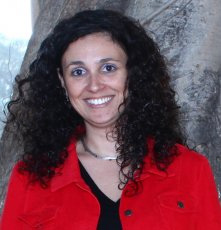
“I believe there is real magic in the way thatembryos develop. I’ve been studying them for almost 15 years and Ihaven’t stopped being amazed,” says Dr. Karina Yaniv of the WeizmannInstitute of Science’s Department of Biological Regulation.
Dr. Yaniv focuses on examining how blood and lymphatic vessels formduring embryonic development. Her research may, in the future, lead tonew therapies for heart disease, stroke, cancer, and other illnesses. “Ithink it’s imperative for us to learn how to manipulate vessel growth,”she says. “Sometimes we want to encourage vessel growth and sometimeswe want to stop it.”
In cardiac ischemia, for example, a partially or completely blockedartery causes a decrease in the flow of blood and oxygen to the heart.As a result, the heart muscle tissue can be damaged. “But if we knew howto grow new blood vessels, we could save that tissue,” says Dr. Yaniv.
On the other hand, selectively blocking the formation of new bloodvessels could help in treating cancer. “Tumors are very, very smart andthe first thing they do when they grow is to surround themselves with alarge amount of blood vessels,” Dr. Yaniv explains. “If we knew how tostop blood vessels from growing, we could potentially kill the tumor.”
In her lab, she uses the zebrafish embryo as a model to study vesselformation. Zebrafish embryos offer unique opportunities for study, asthey develop outside the mother’s body and are nearly transparent, soit’s possible to observe their entire vascular system at every stage ofembryonic development. “We can see the blood cells flowing within thevessels under the microscope, which is invaluable for our research,”says Dr. Yaniv.
The formation and anatomical layout of the zebrafish vascular systemis similar to that of humans and other vertebrates. “From human tochicken to salamander, we all use the same mechanisms to make bloodvessels,” she notes. “I believe that nature has provided us with a greatbook of instructions [on how vessels develop] in the form of theembryo, and all we need to do is learn how to read it.”
By manipulating genes, Dr. Yaniv and her colleagues are able toproduce zebrafish embryos that have more blood and lymphatic vesselsthan normal and others that are lacking vessels. “We’re especiallyinterested in looking at these embryos—which we call mutants—becausethey will teach us how to make blood vessels and how to stop bloodvessels from growing,” she says.
During her postdoctoral studies, Dr. Yaniv showed that, contrary tocommon belief, zebrafish do have a lymphatic system. This system, foundin humans and many other animals, is a network of vessels that helpskeep body fluid levels in balance, absorbs and transports fats, andprotects the body from infection. Thanks to Dr. Yaniv’s findings,several labs in the U.S. and Europe have started using zebrafish intheir studies of the lymphatic system.

Dr. Yaniv also traced the formation of lymphatic vessels in the livingembryo, determining for the first time the developmental history of thissystem—a question that had remained unresolved for the last century.Her studies showed that, in the vertebrate embryo, the lymph vesselsoriginate in the veins. Since metastatic cancer cells use the lymphaticnetwork to migrate to distant organs, a better understanding of howlymph vessels form during embryonic development might make it possibleto block their growth around a malignant tumor and prevent the spread ofmetastasis.
Born and raised in Córdoba, Argentina, Dr. Yaniv received both herBSc in chemistry and biology and MSc in biological chemistry from theHebrew University of Jerusalem, and her PhD in developmental biologyfrom the Hebrew University–Hadassah Medical School. After conductingpostdoctoral research in the Laboratory of Molecular Genetics at theNational Institutes of Health’s National Institute of Child Health andHuman Development (NICHD) in Bethesda, Maryland, she joined the WeizmannInstitute as a senior scientist in 2009.
The Institute’s emphasis on bringing bright young scientists toIsrael has benefited Dr. Yaniv and her family. As a mother of threeyoung boys, she appreciates the opportunity to live on the Weizmanncampus and take advantage of the Institute’s amenities, such as day-carefacilities. “To be a mother and a scientist is definitely not easy, butthe Weizmann Institute helps women like me combine the two and do itwell,” she says.
Dr. Yaniv is also grateful for the ongoing support of her colleaguesin her department. “They’re always offering to help me with my grantapplications, scientific papers, or other projects,” she says. “Theysay: whatever you need, we’re here for you. And that is more than I evercould have asked.”
Dr. Karina Yaniv’s research is supported by the Willner Family Center for Vascular Biology; the Estate of Paul Ourieff; the Carolito Stiftung; the Abraham and Sonia Rochlin Foundation; Lois Rosen, Los Angeles, CA; the Estate of David Arthur Barton; and the Estate of George Talis.
